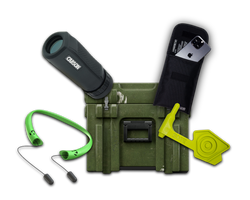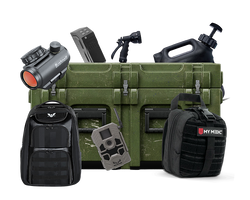Can You Take Self Defense Weapons on a Plane?
Table of Contents
- Introduction
- Understanding TSA Regulations for Self-Defense Weapons
- Self-Defense Tools You Can Consider
- Packing Tips for Traveling with Self-Defense Weapons
- Alternatives to Conventional Self-Defense Weapons
- Conclusion
- FAQs
Introduction
As travelers, we often find ourselves contemplating our safety and security while navigating unfamiliar environments. Whether it’s a bustling airport or a cramped airplane, the question of personal safety looms large. One pressing question that arises frequently is: Can you take self-defense weapons on a plane? With the rise in travel-related incidents, understanding the regulations regarding self-defense tools is crucial for any smart traveler.
Navigating the Transportation Security Administration (TSA) guidelines can be perplexing, especially when it comes to self-defense items. While the TSA plays a vital role in ensuring security during air travel, their rules can often feel restrictive. This blog post will shed light on the key aspects of traveling with self-defense weapons, including what is permissible in both carry-on and checked luggage, and the implications of state laws and airline policies.
From pepper spray to tactical pens, we will dissect various self-defense tools, examining their legality and practicality for air travel. By the end of this article, you will have a clearer understanding of how to prepare for your journey while maintaining your right to personal safety. So, let’s delve into the specifics and arm you with the information you need to travel smart and secure.
Understanding TSA Regulations for Self-Defense Weapons
The TSA has specific guidelines in place to protect all passengers while they travel. Understanding these regulations is the first step in determining what self-defense weapons you can bring aboard an aircraft. Below, we explore the general categories of self-defense items and their specific rules.
Prohibited Items
Many self-defense weapons fall into the prohibited category when it comes to carry-on bags. Generally, the following items are not allowed:
- Firearms: All firearms must be transported in checked luggage, unloaded, and in a locked hard-sided case.
- Knives: Any knives, regardless of size, are banned from carry-on luggage. This includes pocket knives and multi-tools with blades.
- Pepper Spray: Generally, pepper spray is prohibited in carry-on bags but may be allowed in checked luggage under certain conditions.
Allowed Items in Checked Luggage
While many self-defense tools are prohibited in carry-on luggage, some can be carried in checked baggage:
- Pepper Spray: You can bring one container of pepper spray or mace in your checked baggage, provided it is 4 ounces (118 ml) or less and has a safety mechanism to prevent accidental discharge. Importantly, the spray must contain less than 2% by mass of tear gas.
- Stun Guns and Tasers: These items are typically allowed in checked baggage but are prohibited in carry-ons. It's important to package them securely.
- Self-Defense Keychains and Tactical Pens: These items are often permissible in carry-on luggage but may attract extra scrutiny from TSA agents. Be prepared to explain their intended use.
Notable Exceptions and Considerations
- Officer Discretion: TSA officers have the final say on what items are allowed. Even if an item is generally permitted, if it raises security concerns, the officer may confiscate it.
- State and Local Laws: Be aware that laws regarding self-defense weapons can vary significantly from state to state. Always check the regulations of your departure and arrival locations, as well as any layover points.
Self-Defense Tools You Can Consider
When it comes to self-defense while traveling, being prepared is key. Here’s a breakdown of some popular self-defense tools and their TSA regulations:
1. Pepper Spray
As discussed, pepper spray can be a valuable self-defense tool. If you choose to travel with it, ensure it meets TSA requirements. Always check the regulations of your destination, as certain states impose stricter limits on the size and composition of pepper spray.
2. Personal Alarms
Personal alarms are an excellent option for travelers seeking a non-violent means of protection. These small devices emit a loud noise when activated, drawing attention to the user in case of an emergency. Most personal alarms are allowed in both carry-on and checked bags.
3. Tactical Pens
Tactical pens are designed to be both functional writing instruments and self-defense tools. They often feature a sturdy build that can be used to strike an assailant. Generally, tactical pens are allowed in carry-on baggage but may face additional screening.
4. Kubotans
These compact self-defense tools are effective for striking pressure points. Kubotans are typically allowed in carry-on luggage, but as with tactical pens, be prepared for potential scrutiny during security checks.
5. Self-Defense Keychains
These items can include various designs, such as those resembling everyday objects but are designed to be used for self-defense. Most self-defense keychains are permitted in carry-on luggage, as long as they are not perceived as weapons.
6. Flashlights
High-powered flashlights can serve dual purposes: illuminating dark areas and acting as a striking tool in emergencies. They are generally allowed in both carry-on and checked bags; however, ensure they do not have features that could raise security concerns.
Packing Tips for Traveling with Self-Defense Weapons
To ensure a smooth travel experience, follow these packing tips when bringing self-defense items on your flight:
- Research Airline Policies: Always check your airline’s specific regulations regarding self-defense items, as they may have additional restrictions beyond TSA guidelines.
- Be Transparent: Inform TSA officers if you are carrying self-defense tools during the security screening process. This transparency can help alleviate concerns and facilitate a smoother process.
- Secure Packaging: For items like stun guns or pepper spray, ensure they are packed securely to prevent accidental activation. Using hard-sided cases can provide additional protection.
- Stay Informed of Local Laws: Laws regarding self-defense weapons can differ dramatically depending on your destination. Familiarize yourself with the laws in the states or countries you will be visiting.
Alternatives to Conventional Self-Defense Weapons
If you feel uncomfortable with the restrictions surrounding self-defense weapons, consider utilizing everyday items for personal protection. Here are some unconventional tools that can be used effectively while traveling:
1. Everyday Items as Defense Tools
Many common items can serve as improvised self-defense tools. For example:
- Water Bottles: A solid metal water bottle can be used to strike an assailant if necessary.
- Belts and Shoelaces: These can be used for distraction or as makeshift restraints.
- Books or Magazines: Throwing a book can momentarily distract an attacker, allowing you to escape.
2. Personal Safety Awareness
Equipping yourself with knowledge and awareness is the best self-defense strategy. Learning how to remain alert and recognizing potential threats can significantly enhance your safety. Consider taking self-defense classes to improve your skills and confidence.
Conclusion
Traveling with self-defense weapons requires a thorough understanding of TSA regulations and airline policies. While certain items like pepper spray and stun guns can be allowed in checked luggage, many self-defense tools are prohibited in carry-on bags. Always stay informed of local laws and be prepared for TSA officers' discretion during security screenings.
Ultimately, your safety is of utmost importance. By planning ahead and understanding what you can bring on a plane, you can travel confidently and securely. Remember, the best self-defense tool is often your awareness and preparedness. For those interested in further enhancing their tactical gear collection, consider exploring Crate Club's subscription services for curated self-defense tools and survival gear.
For more information on self-defense gear and to explore your options, check out the Crate Club Subscription Services and Crate Club Shop.
FAQs
Can I carry a self-defense weapon on a plane?
Yes, but you must comply with TSA regulations and airline policies regarding carry-on and checked baggage.
What are the TSA regulations for self-defense tools?
Many self-defense tools, such as firearms, knives, and pepper spray, are prohibited in carry-on luggage. Some items, like pepper spray, may be allowed in checked baggage under specific conditions.
Are there any self-defense items allowed in carry-on luggage?
Certain items, like tactical pens and personal alarms, may be allowed in carry-on luggage but may face additional scrutiny.
What self-defense tools can I put in my checked baggage?
You can typically bring one container of pepper spray (4 oz. or less), stun guns, and tactical pens in your checked luggage, provided they meet TSA guidelines.
How do FAA regulations impact traveling with self-defense items in checked baggage?
The FAA has specific regulations regarding hazardous materials. It's essential to ensure that self-defense items comply with these regulations.
What should I know about airline policies and legal considerations for self-defense items?
Always check your airline's policies regarding self-defense items, as they may have additional restrictions. Additionally, be aware of state and local laws regarding self-defense weapons.
Are there any TSA-approved self-defense items?
Yes, personal alarms, tactical pens, and certain self-defense keychains can be considered TSA-approved, but it's essential to verify current regulations.
What should I know about airport security screening for self-defense gear?
Be prepared for additional screening with self-defense items, and inform TSA officers about what you are carrying to avoid complications.
What are the different rules for carrying self-defense weapons on international versus domestic flights?
International regulations may differ significantly from domestic ones. Always check the laws of the countries you will be traveling to, as some items may be entirely prohibited.
Bagikan artikel ini



